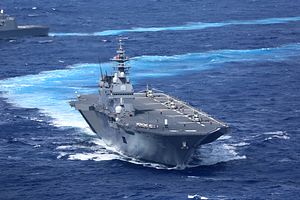Speculation is growing that Japan is preparing to upgrade its helicopter carriers so they have the ability to carry fighter jets such as the F-35B. With the country’s defense program guidelines due to be updated in December, the government is considering upgrading the Izumo-class helicopter carriers, according local media reports, including in the Mainichi newspaper.
When asked this week about “multipurpose aircraft carriers” proposed by the ruling Liberal Democratic Party (LDP), Japanese Defense Minister Takeshi Iwaya said he took the proposals seriously. While he said the government was yet to settle on its policy, he gave some supportive signals about converting the Izumo.
“However, since this is valuable equipment that we already own, I think it would be desirable to use it for as many purposes as possible, and we will continue to conduct research and studies on this matter going forward,” Iwaya said at a press conference on Tuesday.
He confirmed that this research was being conducted as part of the preparation of the National Defense Program Guidelines, due to be released by the end of the year. He also confirmed the government was examining the F-35B fighter: “Since the fighter is equipped with the ability to withstand attacks, and to take off from short runways, we are now conducting studies into it.”
Kyodo News quoted anonymous government sources as saying that Tokyo was considering buying about 20 of the F-35B fighters.
As The Diplomat’s Franz-Stefan Gady has previously explained on these pages, the Izumo is the biggest class of surface warship to be operated by the Japan Maritime Self-Defense Force (JMSDF) since the end of World War II. It can accommodate up to 14 helicopters.
Gady wrote in February that retrofitting the Izumo-class to accommodate the F-35B would result in some curtailing of its sophisticated anti-submarine warfare capabilities. He added:
The Izumo-class conversion debate in Japan occurs in the context of an increasing vulnerability of Japanese airbases to Chinese and North Korean cruise and ballistic missile strikes. F-35Bs operating from Izumo-class carriers would at least theoretically increase the chances of Japanese airpower surviving a possible Chinese or North Korean first strike in the event of a military conflict.
Japan’s latest annual defense white paper argued the basic threat posed by North Korea remained undiminished; it also raised concerns about China’s military moves. According to the white paper published in August, China’s rapid modernization of the People’s Liberation Army, enhancement of operational capabilities, and unilateral escalation of activities in areas close to Japan “are generating strong security concerns in the region and international community, including Japan.”
However, the mooted changes to Japan’s helicopter carriers are likely to attract controversy at home and abroad. The government argues the Japan Self-Defense Forces (JSDF) are strictly defensive in nature, in line with the post-war constitution’s ban on maintaining “war potential.” Prime Minister Shinzo Abe wants to revise the constitution to codify the existence of the JSDF, although he faces political hurdles in achieving that.
The LDP has given up on its plan to present draft amendments to the constitution during the current Diet session, Kyodo News reported this week. That means the task may be deferred to the next Diet session in the first half of 2019. However, as experts have previously pointed out, constitutional revision may be difficult to pursue at a time when Japan is preparing for the abdication of Emperor Akihito, 84, at the end of April. An upper house election next summer could create uncertainty, with the possibility that Abe’s coalition loses its two-thirds super-majority. Constitutional changes require approval by two-thirds of the parliament and then a simple majority of voters in a national referendum.

































